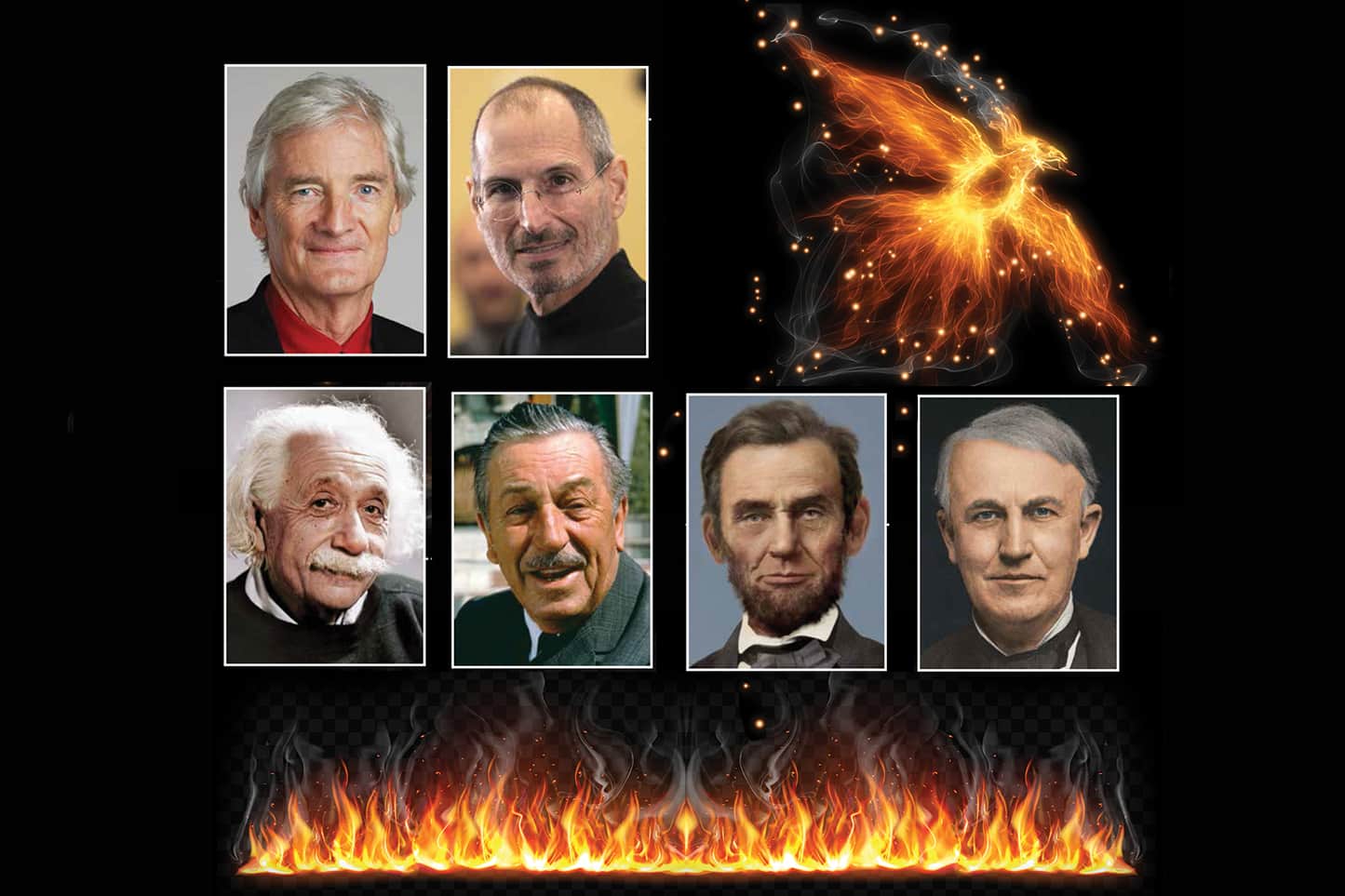Failure is a part of life, as plenty of successful people have found out. Here we take a look at six highly renowned men who failed miserably before achieving great success.
Abraham Lincoln 1809-1865: “My great concern is not whether you have failed, but whether you are content with your failure”
Abraham Lincoln took failure like a good sport and refused to quit until he had become a champion. In 1818 when he was aged nine his mother died, leaving behind an already struggling farm family. Years later, in 1831, he would leave his home to become a clerk/assistant at a general store. This business provided Lincoln with just a few months of work before it failed, and by Spring 1832 Lincoln was unemployed. A year after this he ran for Illinois state legislature and was placed eighth among the 13 candidates. However, it’s been said that this defeat was the only time he was beaten in a direct vote by the people. In 1833 the unemployed Lincoln arranged a loan to purchase a general store in partnership with his friend William F. Berry. The loan was arranged by the previous owner of the store and Lincoln used his part share as security. Unfortunately this venture also failed and once again he was out of work. This debt followed Lincoln around for years before it was finally paid off. After celebrating a victory running for state legislature in 1834 Lincoln was heartbroken just one year later when the woman he intended to marry died. In 1836 he suffered a total nervous breakdown and was bedridden at times, this setback lasted for six months. Upon recovery he sought to become the Illinois House of Representatives speaker but it wasn’t easy – he lost twice as a Whig candidate. The rest of Abraham Lincoln’s story is remarkable and uplifting but surprisingly riddled with failures, including losing to another candidate for the job of Commissioner of the General Land Office in 1849 – six years later a ballot showed that Lincoln won the most votes but was six short of the requisite majority.
Albert Einstein 1879-1955 :“My great concern is not whether you have failed, but whether you are content with your failure”
As a boy Einstein didn’t speak fluently, causing his teachers to believe he was a slow thinker. Aged four he could not speak at all and at seven he was still unable to read. Later his rebellious nature and poor performance led to a rejection letter from Zurich Polytechnic. At times he considered dropping out and selling life insurance as a means to get by. Although he did complete his education it was still a very difficult time for him. His unsupportive father did not recognise his ability, and died still believing that his son would forever be a failure. Shortly after this tragedy Einstein started work as a patents clerk where he would review patents and mathematical equations and this was the beginning of his astonishing career. Famously his work changed how the world thinks, but he did make countless errors in the process. Einstein spent much of his later life trying to find a “unified field theory” that would include his general relativity theory, Maxwell’s theory of electromagnetism, and perhaps a better quantum theory. Most scientists today agree that he failed to do so.
Sir James Dyson b.1947: “Successes teach you nothing. Failures teach you everything. Making mistakes is the most important thing you can do”
You probably have direct experience of using one of the ingenious vacuum cleaners created by Sir James Dyson. His popular Dual Cyclone bag-less vacuum cleaner has revolutionised the industry and netted him a fortune – he topped The Sunday Times Rich List for the first time during 2020. But before his invention appeared in shops Dyson had spent years experimenting with 5,126 failed vacuum cleaner prototypes. Although number 5,127 went into production in 1983 it only sold about 500 units. Meanwhile all of the major UK manufacturers and distributors wouldn’t touch the revolutionary new design as they knew it would damage the lucrative replacement bag market. A Japanese company, however, wasn’t as concerned about this, and approached Dyson in 1985 to licence and manufacture his design. The modified machine called the ‘G-Force’ had an attachment that turned it into a table to save space in small Japanese apartments! This design won the International Design Fair prize in Japan in 1991. Once again Dyson tried to get the support of UK manufacturers for his invention but failed. So in 1993 he decided to launch his own manufacturing company, Dyson Ltd. Television advertising campaigns established Dyson as the face of the UK’s fastest-selling vacuum cleaner. Later his invention was copied by Hoover but in October 2000 a patent infringement court case ordered Hoover to pay Dyson £4 million in damages. However, even during the successful years there continued to be failures such as the ContraRotator washing machine (2000) and the Dyson electric vehicle project which he scrapped in October 2019.
Walt Disney 1901-1966: “All the adversity I’ve had in my life, all my troubles and obstacles, have strengthened me… You may not realise it when it happens, but a kick in the teeth may be the best thing in the world for you”
Walt Disney’s beginnings as a commercial artist started in 1919 with a job in Kansas City that he lost in January the next year! Walt’s next failure was his own commercial art business which he started with his friend and fellow artist Ub Iwerks. After a spell working for a commercial film company he established his own animation company called the Laugh-O-Gram Studio but could not keep that business solvent either and he became bankrupt in 1923. That same year Walt moved to Hollywood where he set up another company with his brother Roy and he persuaded Ub Iwerks to join them. Their output was distributed by Universal Pictures which ultimately led to another problem for Walt. By 1928 Disney hoped to negotiate a larger fee for producing a successful animated series called Oswald the Lucky Rabbit but found that he didn’t actually own the intellectual property rights to the films and therefore had no leverage. After the Disney Brothers Studio was offered an insulting and converse reduction in payments Walt abandoned Oswald and began developing Mickey Mouse, his most famous character. The 1930s saw Walt Disney Productions grow spectacularly but after emerging from the Second World War with the company $4 million in debt, progress was slow and there were more failures to come such as Alice In Wonderland (1951) which lost around a half a million dollars and Sleeping Beauty (1959) which at first was a financial flop, forcing widespread layoffs and company losses. Even the visionary amusement park that he’d been thinking about for two decades – Disneyland – had its detractors. Major Hollywood studios pressured him to not build it, claiming it would hurt the movie industry. Walt boldly did it anyway and successfully captured an audience of millions.
Steve Jobs 1955-2011: “Have the courage to follow your heart and intuition. They somehow know what you truly want to become”
Together with Steve Wozniak, Steve Jobs started the Apple Computer Company in his garage in 1976. Just four years later Apple was a billion-dollar business and a publicly traded company. In 1984 Apple released the Macintosh. In 1985, amid concerns about competition from cheaper Microsoft products, Apple forced out its famous founder. In his 2005 commencement speech at Stanford, Jobs described the loss he felt, “We had just released our finest creation, the Macintosh, a year earlier, and I had just turned 30. And then I got fired. How can you get fired from a company you started? Well, as Apple grew we hired someone who I thought was very talented to run the company with me, and for the first year or so things went well. But then our visions of the future began to diverge and eventually we had a falling out. When we did, our Board of Directors sided with him. So at 30 I was out. And very publicly out. What had been the focus of my entire adult life was gone, and it was devastating”. Jobs considered leaving Silicon Valley, but stayed, realising that he still loved his work. He went on to found Pixar Animation Studios, and NeXT. However, Apple acquired NeXT in 1997, and Jobs became CEO of his former company within a few months. He then developed the iPod, iPhone, and iPad, and revolutionised the way we work, play, and communicate, as well as bringing the company he founded (and was fired from) to unprecedented heights of profitability.
Thomas Edison 1847-1931:“I have not failed 10,000 times. I have not failed once. I have succeeded in proving that those 10,000 ways will not work. When I have eliminated the ways that will not work, I will find the way that will work” Thomas Edison’s road to success was paved with numerous failed and rejected inventions along the way. His story begins with the automatic electrographic vote recorder. A simple machine that could quickly tally vote counts and save officials several hours of time. When he brought his invention to Washington political leaders bluntly rejected it.
His next venture was to sell an electric pen across the Mid-Atlantic, charging agents $20 and their customers $30. The idea was brilliant, but the execution had failed. The electric pens were too noisy and heavy. Even after meticulous improvements another drawback occurred: the batteries needed to remain in a jar of chemical solution. It was a messy product and project, but nonetheless Thomas Edison would eventually sell the rights to the pen to the Western Electric Manufacturing Co. and received royalties.
In 1888, Edison touted the tinfoil phonograph as one of his most promising inventions. The process took nearly a decade to complete with the final result having a tinfoil sheet that was too easily damaged. It could only be used once or twice and storing the sheet was near impossible, not to mention its operation which required skill and patience. In the end it was only suitable for exhibitions or as a curiosity bought by scientists and those wealthy enough spend on novelty items. But Edison refused to give up and revisited the project 10 years later. This time he used a wax cylinder and the product became a success. To fund his research laboratory, Edison began to rapidly produce new inventions and send them off to factories for production and sale. One of these projects included a talking doll with a tiny phonograph inside. It took Edison two years to get his product to market, but once sold to consumers, complaints swarmed in. They were too easily broken by children and the voices coming out of them were quite bizarre and creepy in tone. A month later, the product was pulled from the market.





0 Comments